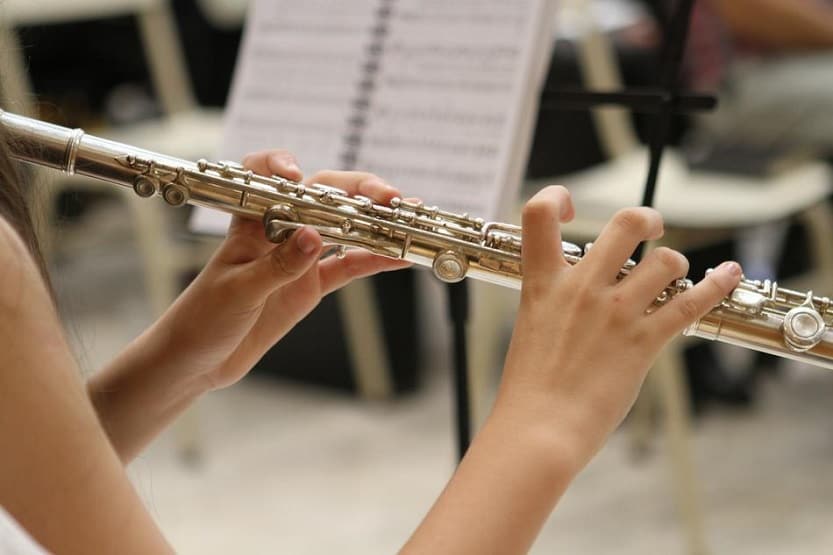You may have heard the flute being described as a woodwind instrument. The normal orchestra flute isn’t made with wood, so is it really part of the woodwinds? Is a flute a woodwind instrument?
The flute is a woodwind instrument as it produces sounds when the musician blows air across its edges or holes. Woodwind instruments do not need a reed to produce a sound as they only need air. They are also called wind instruments.
There is a misconception that woodwind instruments are all made of wood. This is not true as they can be made of wood, platinum, nickel, gold, silver, or a combination of these materials.
Read on to learn more about the flute as a woodwind instrument and how to take care of it to last longer.
Also, we hope you find the links here useful. We may get a commission if you purchase something through a link on this page, so thank you!
Is a Flute a Woodwind Instrument?
A flute is a type of woodwind instrument that produces sounds when you blow air across its edges or holes. Woodwind instruments don’t need a reed to produce a sound because they only need air. It is the reason why they are called wind instruments.
Musicians consider the flute a woodwind instrument because you can produce sound by blowing air into the instrument’s opening. There are two types of woodwind instruments: the flute and the reed instruments.
What is the woodwind family? The woodwind family includes the oboe, flute, piccolo, clarinet, bassoon, English horn, bass clarinet, and contrabassoon.
These instruments were previously made of wood; hence, their name woodwind. However, nowadays, they are made from different materials, such as platinum, nickel, silver, or a combination of these metals.

History of the Flute
The flute is a reedless wind instrument discovered about 35,000 to 43,000 years ago in Germany and Slovenia. A vulture wing bone with human-made holes was found in Germany, and a cave bear’s femur with two to four holes was found in Slovenia.
From then on, researchers discovered flutes in various parts of Germany and Europe. Scientists also discovered flutes made from a mammoth tusk and a swan bone, indicating that Europe has produced the oldest known musical instruments in history.
Eventually, researchers also discovered flute instruments in China, India, Egypt, Israel, and other parts of the world. The Holy Bible mentioned the flute in some of its chapters, referring to it as the chalil (hollow). Indian culture also included the flute as one of its early musical instruments. Many flutes in that era were made of shin bones.
Soon, enterprising people made flutes from small bamboo poles and wood by creating small holes along its length. The flute eventually evolved into a woodwind instrument. However, manufacturers build flutes from various materials, such as bronze, silver, platinum, nickel, or a combination of these elements.
So why is a flute a woodwind instrument? Woodwinds are a class of instruments controlled by breath where the vibration is not caused by the lips. Generally, the woodwind family includes single reeds (saxophones, clarinets), double reeds (bassoons, oboes), and flutes (recorders, fifes, flutes). Traditionally, most woodwinds were made from wood, but now, many woodwind instruments are made of brass, silver, as well as other metals such as gold and platinum.
Is Playing the Flute Easy to Learn?
Playing the flute is easy to learn because you don’t have to memorize dozens of keys. It’s like blowing across the bottle top and then using the keys to change the notes. You can learn the skill through constant practice.
You may want to hire an expert flutist if you have the financial means to pay for flute lessons. If not, you can always learn by yourself. There are various YouTube videos on how to play the flute.
Nevertheless, you should consult an expert or certified repair person when repairing, replacing, or adjusting the flute’s head crown or cork. When you do this task incorrectly, it could damage your flute as these parts are prone to wear and tear.
How Can You Tune Your Flute?
Tuning is crucial with this woodwind musical instrument. You can play the composer’s piece correctly if your flute is tuned precisely. So, before you play, ensure you have adjusted your flute appropriately.
It would be best if you had a tuning rod and a tuner (physical tuner or online app) to tune your flute. You can consult a technician to adjust the flute’s cork.
Using the tuning rod and the tuner, adjust your flute’s tune according to the pitch you want to use in your piece.
Factors Affecting the Flute’s Tune
1. Flute’s Length
The flute’s length will affect its pitch range – the longer the flute, the lower its pitch tends to be. You can easily adjust the pitch through the headjoint adjustments. Moreover, you can raise your pitch by shortening the flute tube and firmly and carefully pressing in the headjoint in a twisting motion. A chromatic tuner will help tune your flute correctly.
You could also lower the pitch by doing the opposite. Lengthen the flute and pull out the headjoint until the pitch matches that of the chromatic tuner.
2. Flute’s Pitch
If your flute is flatted or sharped (one pitch lower or one pitch higher), your flute’s tune may not play correctly. You should use a chromatic tuner to find out if your pitch is the correct one before playing. Therefore, it would help if you calibrated your flute correctly to play the music piece smoothly.

3. Environment
The environment plays a crucial role in your flute’s tuning. When the temperature is hotter, the flute tends to play sharp, and when the temperature gets colder, the flute tends to play flat. Hence, you have to keep your flute’s temperature within the playing temperature, which is not too cold or too hot.
Cold air usually resists vibrating sound waves, producing a lower pitch/tune. You can warm up the flute by breathing into it several times.
4. Player
The way a musician plays the flute affects its tuning too. The airspeed, angle, and air volume in which you play the flute will affect tuning. Also, if you cover the flute’s embouchure, too much can produce flatter tunes. How you position your lips can also affect the pitch.
What type of instrument is a flute? Is a flute a woodwind instrument? A flute is considered a woodwind instrument due to how it produces sound. It produces sound through its opening grooves or holes when the musician blows air into any of these openings. This is similar to other woodwind instruments.
How to Clean Your Flute
Proper cleaning is essential in maintaining the longevity of your woodwind musical instrument. You can perform these simple steps to clean your flute:
1. Clean the Flute’s Interior
Wipe the inside of the flute using a clean, soft cloth by swabbing it. You can also wrap the cloth around the cleaning rod that comes with the flute to prevent scratches. After cleaning, wipe clean the condensation on the rod as well.
2. Clean the Flute’s Exterior
Wipe the outside of the flute, taking care not to scratch or damage it. Metals can easily scratch metal flutes, so avoid direct contact with a metal cleaner. You can use cleaning materials specifically made for flutes.
3. Place in a Secure and Sturdy Case
After cleaning and drying all the flute’s interior and exterior, keep the flute in a secure and sturdy case, away from extreme temperatures. Moreover, place it out of reach of children unless your kids are learning how to play it.
Care Tips for the Flute and Other Woodwind Instruments
1. Keep the Flute Clean at All times
You have to wipe the inside and the outside carefully with a soft cloth after each use. You can swab the inside of the flute to remove moisture that may have built up. This process is commonly called drying. You could use the cleaning materials that come with the flute set. Drying your flute would extend its lifespan.
2. Store the Flute Properly
Store your flute safely in a suitable sturdy case and place it in a secure area that prevents moisture formation. Don’t put it on top of places where people could sit on it accidentally. Ensure that the storage temperature is not too hot or too cold. Also, use a flute stand when taking a brief break from playing.
3. Clothing and Jewelry Could Damage the Flute
Upper clothing with zippers and buttons, such as cardigans and jackets, can scratch and damage your flute. Similarly, jewelry, such as rings and other finger-ornaments, can also damage the instrument. Remove them from your fingers if you play the flute to prevent scratching or damaging it.
4. Ensure That the Flute’s Headjoint Is Not Too Tight or Too Loose
You have to double-check if the headjoint is adequately secured. It should not be too tight or too loose. You may want to consult a skilled repair flute technician to ensure that the part is correctly placed. If you are experienced enough to do it, then go ahead and adjust the headjoint.
5. An Expert Flute Technician Should Do an Annual Maintenance
An expert flute technician must perform regular annual maintenance of your flute. The technician will need to oil, clean, and adjust your flute every year to keep it in tiptop shape.
You could spot minor damages and repair the flute through this annual maintenance before the damage gets worse. If money isn’t a problem, you may want to have a flute check every six months.

6. Learn How to Assemble Your Flute
Assembling your flute is one task that you must learn to take good care of your instrument. Be careful with the flute’s keys when assembling. Don’t touch the keys unnecessarily, as they might get bent or damaged. When the keys are damaged, the flute’s sound will deteriorate as well.
7. Avoid Pulling the Flute’s Headjoint Using the Lip Plate
You can damage the instrument when you pull the lip plate to adjust the headjoint. The reason is that the lip plate is movable, and you may move the plate from its original position.
Pull the headjoint slowly by twisting gently. Check the A (reference pitch) now and then before pulling any further. When the lip plate is dislodged, you will not be able to play the flute properly.
8. Get Insurance for Your Flute
You must ensure that your flute is included in your household insurance policy, or better yet, get standalone insurance for your flute. It pays to play safe than sorry later on.
Standalone insurance policies must cover all aspects of your flute, most especially the keys. The insurance must also cover the cost when the flute gets damaged, repaired, or lost.
What type of instrument is a flute? Is a flute a woodwind instrument? The flute is part of the woodwind instrument family due to how it produces sound. It produces sound through its opening grooves or holes when the musician blows air into any of these openings. This is similar to other woodwind instruments.
Conclusion – Is a Flute a Woodwind Instrument?
A flute is a woodwind instrument because it produces sounds when a player blows air across it or on its edges. A flute does not need a reed to produce a sound. It only needs air. That is why it is called a wind instrument.
Your flute can last longer if you follow the tips mentioned above and treat it as a fragile musical instrument. Enjoy learning how to play the flute. Eventually, you will have fun playing your favorite music piece.
Related reading:
Oboe vs Clarinet – What Is the Difference Between Them?
Easy Clarinet Songs [Top 10 Easiest]








![Read more about the article Easy Clarinet Songs [Top 10 Easiest]](https://musicalinstrumentpro.com/wp-content/uploads/2021/10/Easy-Clarinet-Songs-300x200.jpg)
